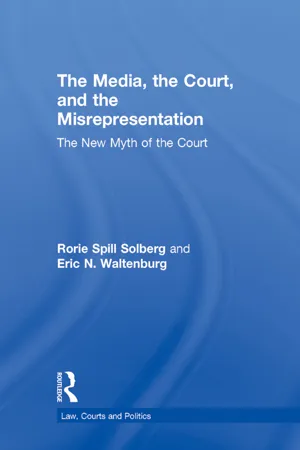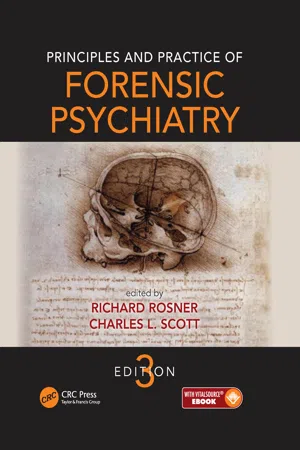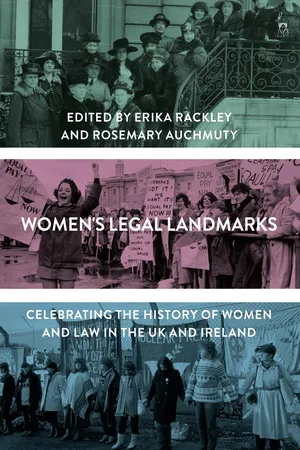Law
Landmark Legal Cases
Landmark legal cases are court cases that have had a significant impact on the interpretation of the law. These cases often establish new legal precedents or clarify existing ones, and they are frequently cited in future legal proceedings. Landmark cases can cover a wide range of legal issues, from civil rights to criminal law to environmental regulations.
Written by Perlego with AI-assistance
Related key terms
3 Key excerpts on "Landmark Legal Cases"
- eBook - ePub
The Media, the Court, and the Misrepresentation
The New Myth of the Court
- Rorie Spill Solberg, Eric N. Waltenburg(Authors)
- 2014(Publication Date)
- Routledge(Publisher)
The Decisional Myth, Part 2—The Landmark CasesIn this chapter, we continue to explore the “cult of personality” by focusing on the oversaturation of the Court’s docket found in chapter 3 . Here, we analyze the coverage of the Court’s docket in terms of the media’s treatment of those cases that have been identified as “landmark rulings” rather than by issue areas. The key question is how might the public’s image of the Court be affected by media coverage of both types of cases when they are highly salient (politically, legally, or both)? Since landmark cases tend to deal with profound social and legal issues, oversaturation on these issues may lead to a more realistic representation of the Court’s work. However, if the coverage of landmark cases is skewed toward the politically charged case, regardless of its legal implications, the image of the Court may be distorted, as we found in chapters 2 and 3 , as will be the public’s perception of the Court’s work. In this chapter, we begin with an examination of landmark cases as a whole, describing overall differences within this subset of cases compared to the other cases on the Court’s decisional docket that the media covered, but that were not necessarily recognized by history as seminal. We then focus more narrowly on the coverage of the landmark cases for each term—the issue areas highlighted and the major decisions that garner media attention. We end each of these separate analyses with a comparison between the landmark cases and the non-landmark cases covered in that term, specifically focusing on which cases serve as “news pegs,”1 to tease out any additional significant differences in coverage of these major cases.In terms of identifying salient cases, there are two main metrics. Often scholars will simply utilize the paper of record, the New York Times , and note whether a case appears on its front page (Epstein and Segal 2000). Given the paper’s reputation and our prior analyses that show that the New York Times simply covers more than its competition in relation to the Supreme Court, this measure makes perfect sense. However, for our purposes it would be a tautological indicator. Simply put, we cannot use the New York Times to identify each term’s most salient cases and then profoundly note that the New York Times was the best at covering such cases. Therefore, we turn to the second common metric—whether the case makes the Congressional Quarterly list of historic or landmark cases. The latest listing appearing in the Guide to the U.S. Supreme Court ends with the October Term 2009. Therefore, the fifth edition of the Guide , as identified and compiled by Los Angeles Times - eBook - ePub
- Richard Rosner, Charles Scott(Authors)
- 2017(Publication Date)
- CRC Press(Publisher)
Judicial decisions serve as precedents only within the same judicial system or jurisdiction: for example, a decision of New York’s highest state court (the Court of Appeals) is binding precedent only in that court and in New York’s lower courts. It has no binding authority for future cases adjudicated in the courts of New Jersey, California, or any other state system. Even decisions of the U.S. Supreme Court are not binding on state courts unless a federal question or constitutional interpretation was at issue. The higher a court stands in the hierarchy of its own jurisdiction, the greater force as precedent its decisions are accorded. (For example, decisions of the Supreme Court of California are binding on all lower California courts, whereas decisions of the intermediate appellate courts have much less precedential authority and are liable to be overruled at some future date by the higher tribunal. Subordinate courts must always adhere to precedents of higher courts with supervisory jurisdiction over them.)American courts have never regarded the doctrine of stare decisis as absolutely binding, as have English courts until quite recently. Sometimes legal rules become antiquated or obsolete and innovation and responsiveness to social change call for the abandonment of an established precedent. In such cases, the highest courts have reserved the authority to overrule or set aside their own past decisions, when public policy considerations and the proper development of the law require a change. Courts do not lightly make use of their prerogative to overrule their own clear precedents. Generally they agree with Cardozo that “adherence to precedent should be the rule and not the exception” (Bodenheimer et al. 1980, 68).LEGISLATION
Legislation, as a source of the law, has been compared to a proverb, while case law has been likened to a parable. The latter is composed of principles inferred from decisions handed down in particular cases that decided concrete disputes between parties. The former is an authoritative, prescribed general rule, promulgated by a lawmaking body. According to Patterson,A proposition of case law may be correctly stated in several different ways, each of which is equally official. A statute (proposition of legislation) is stated as an exclusive official wording of the rule. Case law is flexible; legislation is (textually) rigid. (Jones et al. 1980, 12) - eBook - ePub
Women's Legal Landmarks
Celebrating the history of women and law in the UK and Ireland
- Erika Rackley, Rosemary Auchmuty(Authors)
- 2018(Publication Date)
- Hart Publishing(Publisher)
1 Women’s Legal Landmarks: An Introduction ERIKA RACKLEY AND ROSEMARY AUCHMUTY Landmark [land-mahrk] Noun:1. a significant event, juncture or achievement marking an important stage or turning point in something;2. a prominent or distinguishing object or feature that is easily seen, especially at a distance, which serves as a guide and/or that marks a site or location.Verb (used with object):1. to declare (a building, occasion) a landmark.2019 marks the centenary of women’s formal entry into the legal profession. This was, of course, a key legal landmark for women. But it was not the first: feminists have long had recourse to law as a key means of achieving equality. Nor was it the last: there have been, and continue to be, important legal advances for women. Women’s legal history is full of landmarks, turning points in law’s response to women’s lives and experiences. The Women’s Legal Landmarks Project was a multidisciplinary collaboration involving feminist scholars engaging in the process of ‘landmarking’ key legal events, cases and statutes for women in the UK and Ireland. Our aim was to offer a scholarly intervention into the recovery of women’s lost history by combining legal and historical expertise to create the first scholarly anthology of legal landmarks for women. Together we worked to produce a collection of landmarks that demonstrated women’s agency and activism in the achievement of law reform and justice. This book is the result.I. The Women’s Legal Landmarks ProjectAs with many good ideas, the impetus for the project arose out of an afternoon of procrastination. A chance happening upon the blurb of a promised but yet-to-be-written book led to a conversation about the possibility of a large, collaborative project – along the lines of the UK Feminist Judgments Project1
Index pages curate the most relevant extracts from our library of academic textbooks. They’ve been created using an in-house natural language model (NLM), each adding context and meaning to key research topics.


